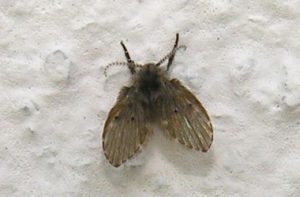Fruit Flies
Description
Drosophila melanogaster is a species of small fly. Adults are 3 to 4 mm long, may have red eyes, though some are dark eyed, and a tan thorax. The abdomen is black on top, gray underneath. Fruit flies can appear to be brown or tan in color. Populations tend to build during the summer, becoming very abundant at harvest time. Indoors, fruit flies are frequently active at all times of the year. Fruit flies eat ripened fruit and vegetables and fermenting products.
More Information
Like other fly species, fruit flies experience a four-stage life cycle —beginning as eggs, they undergo larval and pupal stages before emerging as adults. The early life stages span approximately a few days and fruit flies can complete their development in as little as one week in ideal temperature conditions. Adult fruit flies can live up to 30 days.
The common fruit fly is known for its ability to reproduce rapidly. The common fruit fly is a useful specimen in scientific research. The rapid life cycle allows researchers to study the effects of an experiment over a number of generations. Mutations are also common and easily followed in this fly species. Fruit flies have only four pairs of chromosomes: three autosomal pairs and one pair that determines sex. The entire compact genome of the common fruit fly was sequenced in 1998.
Management
- The first step in order to get rid of Fruit Flies in the kitchen or elsewhere is to have proper sanitation. It is critical to eliminate any breeding sources.
- Clean garbage cans and dumpsters. They should have tight lids.
- Ripened fruit should be eaten or refrigerated.
- Get rid of any extra moisture with proper drainage.
- Use screens on building openings.
- Re-grout tiles in bathrooms and kitchens; this will prevent any water leakage in the walls and possible fruit fly breeding sources.
Look first for fruit fly sources in areas where vegetables or fruits are stored outside refrigeration. Also look for fruit fly sources in garbage cans, under appliances, and recycling bins. Even a little spilled juice behind an appliance can contribute to their breeding. When searching for fruit fly breeding sources, remember that the larva can only survive in decaying organic matter that is moist. All stages of a fruit fly infestations depend on organic debris to complete the fruit fly cycle. Whenever possible, food and materials on which fruit flies can lay their eggs must be removed.
Killing adult fruit flies will reduce infestation, but elimination of fruit fly breeding areas is necessary for good management.
Fruit Flies are not the only small fly that you may see in your kitchen area. If you see a small type of fly or gnat type of fly, it may not be coming from the drains. They could be coming from various sources like rotten fruit, garbage, or other damp organic matter. Also, Fruit Fly Traps would not work for other small flies such as Drain Flies, Phorid Flies, or Sphaerocerid Flies.
Pesticide treatments are not the best long-term solution. Although insecticides can kill adult fruit flies, they do not kill the eggs. Thorough cleaning and removal of their breeding source are the key to breaking the life cycle and eliminating a fruit fly infestation.
FRUIT FLIES

Fruit fly information sheet download »
THIS DOWNLOADABLE INFORMATION GUIDE HAS THE STEPS YOU SHOULD FOLLOW TO ELIMINATE A FRUIT FLY INFESTATION.
DRAIN FLIES

Drain flies love to munch on the decaying gunk that builds up in your drains – hair, grease, food scraps, you name it. This is their main food source. Drain and Sewer Issues: Clogged drains, leaky pipes, or other problems within your sewer or septic system can cause standing water.
HOUSE FLIES

House flies are one of the most common insects on the planet. They breed and feed in filth, including garbage, feces, and rotting or spoiled food. Poor sanitation and ripped screens and unsealed cracks in windows and doors can lead to house fly infestations.
✓ Certified Technicians
✓ Extensive Industry Training
✓ Established in 1896
✓ Inspections
✓ Environmentally Conscious
✓ Full-Service Solutions
✓ FREE Consultations
✓ Maintenance Programs
✓ Rodent Exclusion
✓ Bed Bug Canine Inspections
✓ Guaranteed Satisfaction
✓ Emergency Service

